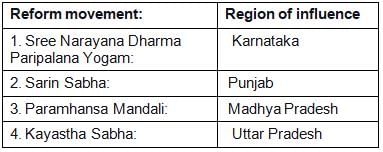Arya Samaj: A Hindu Reform Organisation
- Incorrect Statement 1: Arya Samaj was founded by M. G. Ranade in 1875.
The first statement is incorrect. Arya Samaj was actually founded by Swami Dayananda Saraswati on 7 April 1875 in Bombay (now Mumbai), Maharashtra. M. G. Ranade, on the other hand, was a prominent social reformer and activist in the late 19th century, but he was not involved in the founding of Arya Samaj.
- Statement 2: It sought to revive Vedic learning and combine it with modern education in the sciences.
This statement is correct. Arya Samaj aimed to reform Hindu society by promoting Vedic learning and combining it with modern education in the sciences. Swami Dayananda Saraswati believed in the importance of education and advocated for a harmonious blend of traditional Vedic knowledge and modern scientific knowledge.
- Statement 3: It regards the Vedas as infallible.
The statement does not provide any information about Arya Samaj's perspective on the infallibility of the Vedas. However, it is important to note that Arya Samaj considers the Vedas as the highest authority in matters of religious and moral guidance. They emphasize the importance of Vedic texts and teachings in their reformist ideology.
- Incorrect Statement 4: Arya Samaj professed 'Shuddhi' to bring back to the Hindu fold those who had recently converted to Islam.
The fourth statement is incorrect. While Arya Samaj did engage in the practice of 'Shuddhi', it primarily aimed to bring back those Hindus who had converted to other religions, such as Christianity or Islam, rather than focusing on recent converts to Islam specifically.
In conclusion, the correct answers are:
a) 1 only

















